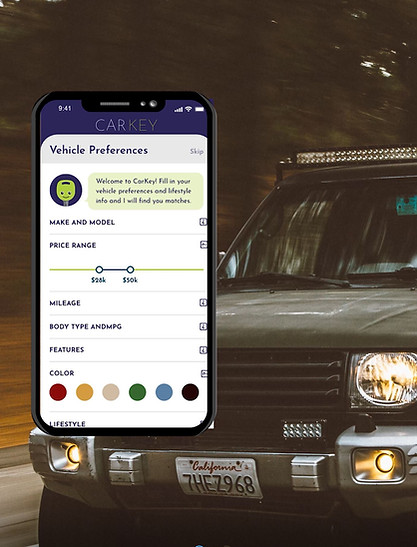
CarKey
My role
This is an academic project (Oct-Dec 2021) on which I worked when I was enrolled in the UX-III Module of the ‘User Experience’ certification program conducted by UCLA Extention. I worked in a team of four following user-centered design principles of UX research and design.
Tools
Pen & Paper, Mural, Figma, Photoshop, Illustrator, Photoshop, Slack, Zoom, Adobe After Effects
The problem
There is a need for a more resilient, transparent, and enriching car buying process that could benefit and satisfy all key stakeholders.
How might customer-car dealer tensions be eased in the car buying process?
The goal
Finding a holistic solution for a car dealership car buying experience. We intended to leverage a human-centric lens to look at the car buying experience in the traditional format that it is in now and identify ways to re-contextualize and make the overall experience more relevant to today's shopping and exploring behavior.


Solution
Our goal was to design an omnichannel process: personalized and fun.
In conclusion, we were able to design a hybrid solution that addresses changing buying habits and needs and helps guide and inform the customer throughout their car-buying journey.
Watch the ad for CarKey below.
Immersion
Assumption grids, empathy maps, HMW, Hypothesis
We wanted to immerse ourselves in the process. So we started with a collaborative workshop to recognize how to empathize with a
human-centric lens. We created an assumption grid map and empathy map to further test in the research phase.

Empathizing with the buyer

Assumption grid
Empathy Map
What do customers want?
Quick, easy-to-use method of car buying
Improved F&I process.
Freedom of choice in car buying process
Transparency and trust in the process.
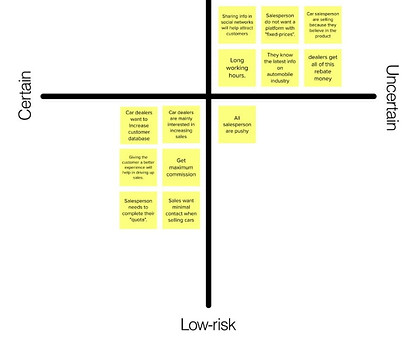
Empathizing with the salesperson
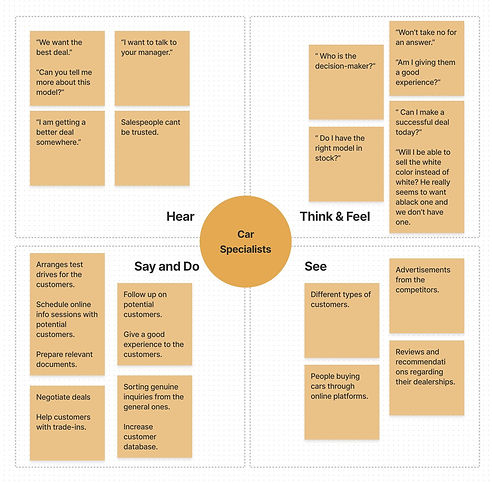
Empathy Map
Assumption grid
What do the car specialists want?
Efficiently take the customer through the car-buying process
Gain and maintain customer relationships, and loyalty
Generate income
Know that their customers are truthful.
How Might we?
Increase transparency between the customer and dealership.
Create ease and comfort at the point of sale?
Make the car buying experience more efficient?
Further, explore physical/digital solutions?
Research
User survey, user interviews, contextual inquiry, desk research, online ethnography, persona, customer journey map
Research Analysis
Affinity maps, Key Insights, Jobs to be done
Based on our hypothesis, we started to perform more qualified research. We explored various techniques, tools, and strategies to understand what works best for us. Our goal was to be able to drive this project by making decisions on how to best solve the design challenge.
User Survey
We surveyed twelve buyers to identify their preferences, goals and pain points.
Some of the pain points identified were:
-
Misinformation
-
Negotiating a good deal
-
Dealing with pushy/aggressive salesperson.
-
Time-consuming F&I process
-
Long wait time.

User survey insights
McKinsey Advanced Industries, U.S., "Innovating automotive retail," Feb. 2014 and Google/TNS, U.S., Auto Shopper Study, Consumer Barometer n=526, 2016.
Changing shopping trends
The average car buyer used to visit five dealerships. Now, with online research,
that number has dropped to two.
"When I got the car the technology used for the car was satisfactory. But the unsatisfactory part was in the dealership, how they dealt with me. There was not enough transparency in the contract."
"When I bought my Honda Pilot everything was done. I was supposed to go to trade cars. And I had to wait two hours to get my new car. The wait and financing were frustrating."
"Buying the car is frustrating. It's long. You have to stay in the dealership for at least a couple hours. Dealing with people you never met before. You might not trust them, but you have to.
Buyer Interviews
We interviewed 5 participants ranging from 29 to 56 who either recently bought a car or were currently in the process of buying one. We also collected information from online forums (Reddit/quora) and articles.
Common Needs
-
Transparency with price and deals (online vs. in-person)
-
Easy access to car facts and complete information about the buying process
-
Virtual options as well as in-person
-
Adequate time to spend with the car before buying
Common Pain Points
-
Not enough time to test drive
-
Reservations about dealerships and interacting with salesmen
-
The buying process is too time-consuming
-
Lack of transparency and price negotiation power
Dealership Research
We wanted to better understand the ins and outs of the dealership and figure out what their problem areas and needs were. We interviewed 1 participant from a dealership and gathered other research from forums (Reddit/quora) and articles.
Common Needs
-
Generating new potential customers
-
Enough inventory for customers to test-drive/buy
-
Return customers
-
Meet their sales quota every month
Common Pain Points
-
Internal politics between Salespeople and their managers
-
Customers have a negative perception towards car buying
-
Lack of transparency, especially around pricing
-
Selling cars for little to no profit (low MSRP)
-
Not enough inventory for the demand
-
Rising trend of online buying with an outdated selling model
"The biggest challenge to engage the customers is to convince them either the car has the latest technology for rich customers, or best buy for their limited budgets. The principle of money for value prevails."
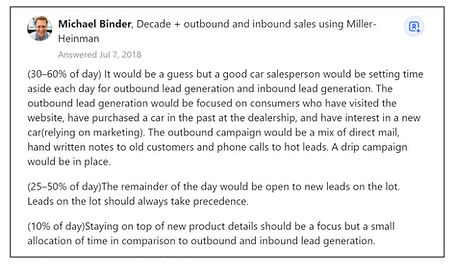
Reddit review - salesman
Research findings and insights
-
Youtube greatly influences customers.
-
The relevance of third-party apps plays a large role in the car-buying process.
-
Customers have reservations about dealerships and interacting with salesmen.
-
Customers are looking for easy access to car facts and complete information about the buying process.
-
People value the power of choice and customization.
-
Lack of transparency and price negotiation power.
-
The buying process is too time-consuming. Customers want more test drive flexibility.


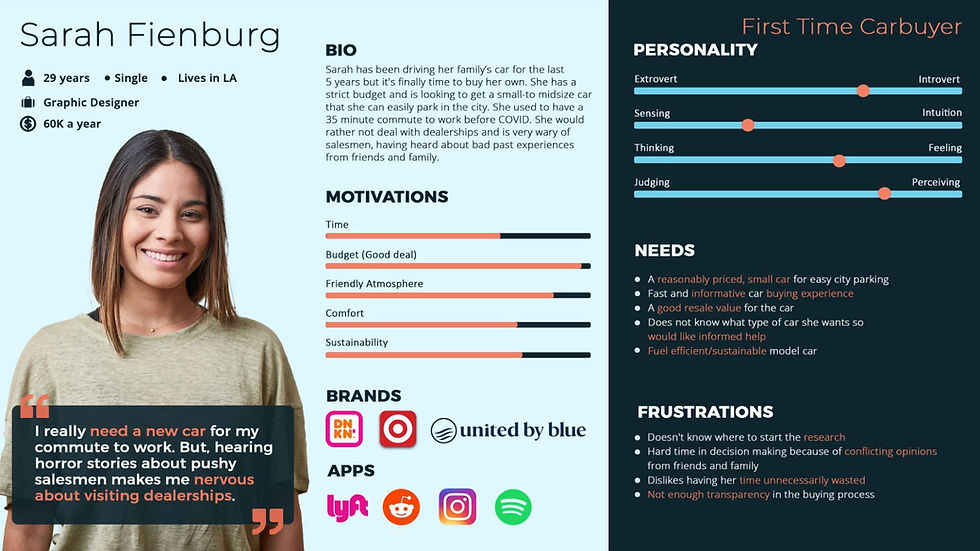

Persona Development
We worked on creating our personas that could address the stakeholder's needs and pain points.
Customer Journey Map
The customer journey map was created using information gathered during research and customer persona.
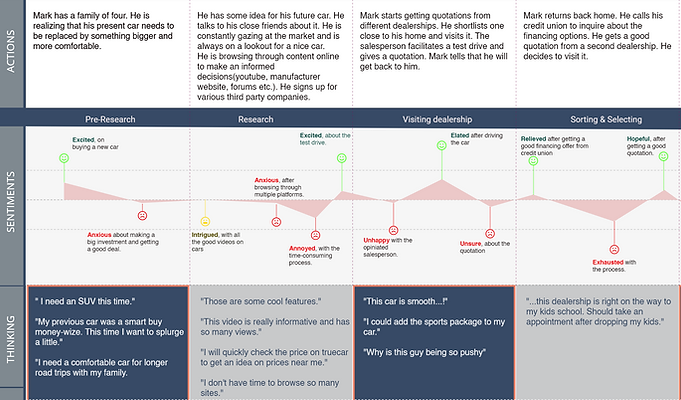

The intent was to:
-
Identifying opportunities in stages which can maximize customer value while minimizing activities or choices that create waste.
-
Developing insights on the whole customer cycle to get a more strategic view.
Research Analysis
Based on the research above, we tried to develop key insights and jobs to be done which could help us move to the ideation process.


Ideation
Brainwriting, brainstorming session, Clustering, and dot methods, crazy 8s and solution sketching, future state journey map, dramatic arcs
Brainworking and brainstorming
We started our ideation process by looking back at our HMW questions to generate ideas. We then leveraged the clustering and dot voting method to select and sort them. The workshop helped us in warming ourselves to the ideation phase.
What is the big idea?
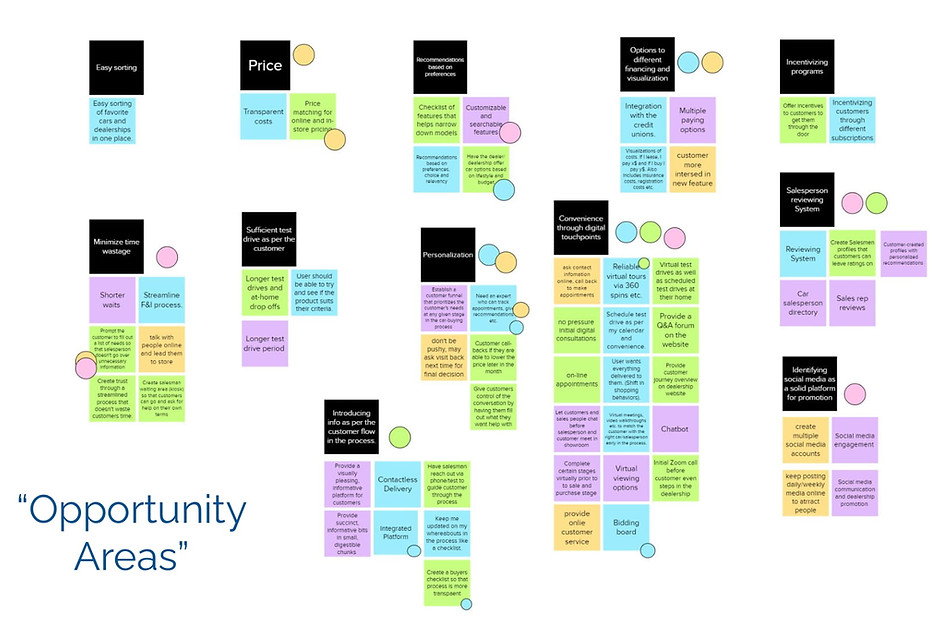
Brainworking and brainstorming
Our team then explored various other ideation methods like crazy 8s and solution sketching, future-state journey maps, dramatic arcs, etc. to further generate new ideas and work on the existing ones.

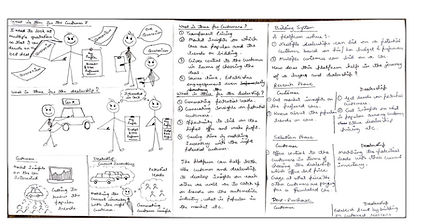-2.jpg)
-1.jpg)
Dramatic Arcs
Solution sketching
Narrowing the focus
Through multiple collaborative workshops, we generated multiple ideas. We started then narrowing our focus with our ideas falling under these four major categories. We then did further research and ideation to come up with two possible solutions that incorporated these areas.
Early Engagement
-
Review and rate agents and cars.
-
View incoming inventory and sign up for a waitlist.
-
Incentives through various subscriptions.
Easy 1:1 communication
-
24/7 communication outlet.
-
Quick scheduling of appointments as per customers calendar; test driving, visiting showroom, servicing etc.
Customization & personalization
-
Recommendations based on customer preferences and lifestyle.
-
Checklist/steps of where you are at in the buying process.
Streamlining F&I
-
Personalized financing.
-
Integration with credit unions, DMV, etc.
-
Visualization of all costs easily.
Searching for the big idea
Brainstorming Ideas that we feel can enrich the customer journey and drive revenue for the dealership.
Bidding Board (Initial Idea)
Transparent pricing and negotiating a deal are the biggest pain points for customers in the car buying experience.
The bidding board is a digital platform where users
can buy and sell cars through a bidding system.
Pivoting and Learning
We realized we were too focused on the digital touchpoints and needed to develop better insights.
As per our research & ideation, we needed a holistic solution that spans through:
Digital touchpoints + Changing trends + Physical space
The big idea
Chatbot Integration + Rate and review system
Our final product is an omnichannel platform that gets rid of the need to negotiate, offers complete customization, and combines digital and physical processes
ADDRESSING THESE CORE PROBLEMS
Lack of transparency between the customer and dealership
Anxiety and feelings of lack of control surrounding the point of sale
The negative stigma of sales agents
Time-consuming process
Prototype
Investigative Rehearsal, Subset, Business model canvas, Sketching, Moodboard, Digital scriptwriting, Wireframing, 3d modelling, Visual design
Identifying ideas to test
We then started building and iterating on a prototype to understand the wider end-end experience. We started off by creating a future state journey map that incorporated our ideas and was able to further discover and pinpoint areas that needed improvement.
-12.jpg)
Evaluating the future state journey map
-03.jpg)
-04.jpg)
Understand service processes, experiences, and digital artifacts
Some of are takeaways are that we need to empower the customer to make decisions, create trust points in the journey, make the process intuitive and easy to learn, and minimize clutter.
We put together a mood board to help us visualize the intended design direction and to help communicate the overall look and feel for the final prototype.
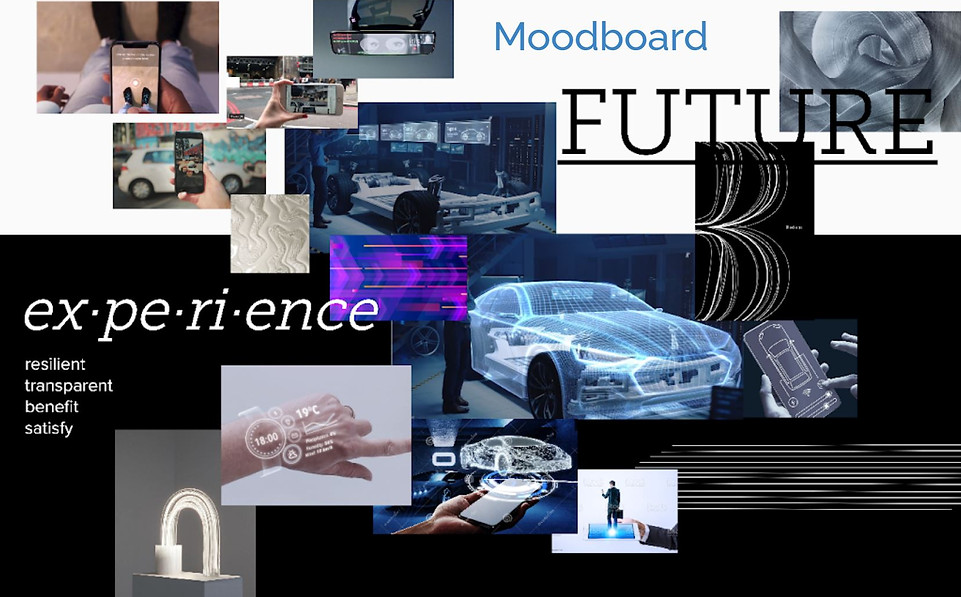
Understanding physical objects and environments
We explored this through sketching, cardboard prototyping, and 3d modeling. You can see in this innovative model, customers visit a dealership with a QR code specific to their selection and try out their preferred model using state-of-the-art VR technology and kiosks.
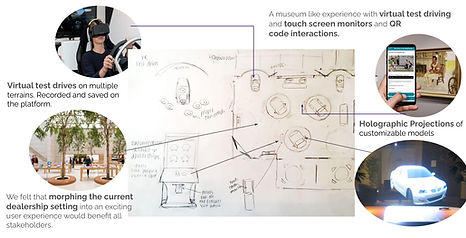-05.jpg)
Sketching
-06.jpg)
Cardboard Prototyping
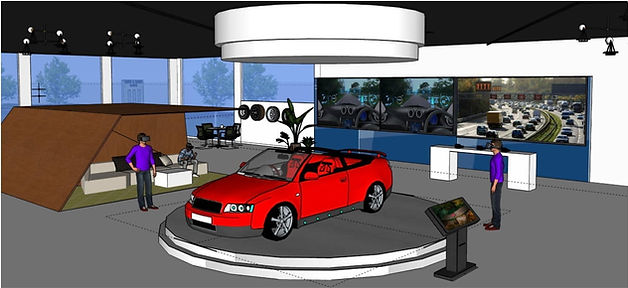-14.jpg)
3d Modelling
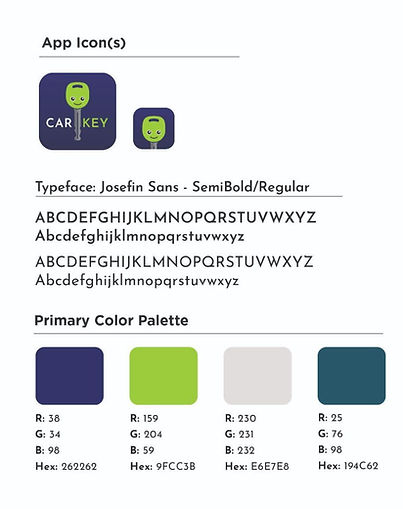-3.jpg)
Visual Design
After some brainstorming, our team chose the name: CarKey.
CarKey not only describes what our product sells but also provides a fun play on words. Key represents both the customer’s future car and the key to the roadmap that will lead customers to their future car.
We then decided on a strong yet playful color palette, purple for respect and knowledge and green to represent the future.
Final Assets
Assumption grids, empathy maps
-3.jpg)
Loading Screen
Home Screen
-4.jpg)
Home, Preference, and My cars Screens
-5.jpg)
Product Specialist chat and Calendar Screens
-7.jpg)
Account, Purchase and SpecialistRating Screens
-6.jpg)
Visualizing space and layout
Designing the future in-dealership experience.
3D model of a future dealership

Final Thoughts
-
Based on our market research (amazon, apple, tesla, etc.) as well as user research, we realized that there was no ‘one solution fits all.
-
You will work more efficiently as a team when you utilize team members' strengths and diverge and converge accordingly.
What's next?
I want to further work on visualizing how much more personalized can the experience be. As per the research by McKinsey, the future holds the option to purchase a car + package, tailored especially as per the customer needs. The car price may become fixed while the package may vary depending on the type of services chosen.
